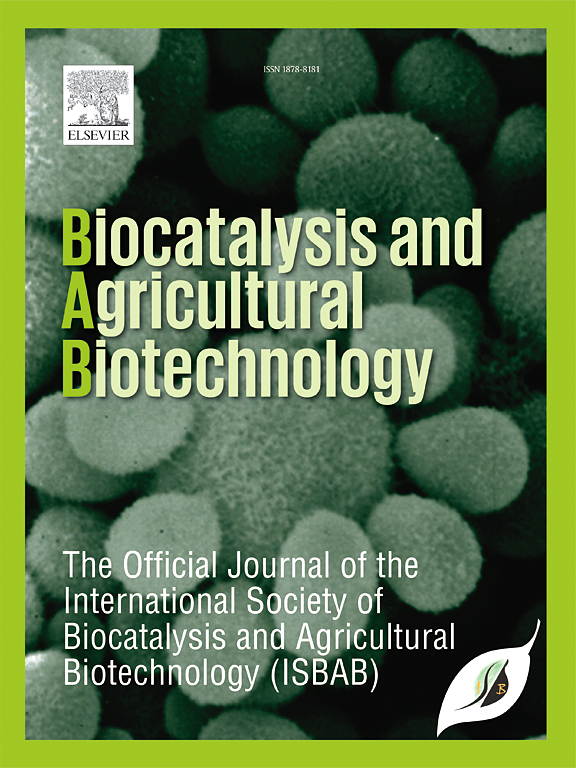Enhanced lipase production and characterization from Aeromonas media VBC8: Applications in biodegradation of lubricating oil waste
IF 3.4
Q2 BIOTECHNOLOGY & APPLIED MICROBIOLOGY
引用次数: 0
Abstract
This study aimed to explore the potential of a novel indigenous strain for the improved production of lipase from castor oil-contaminated soil. Among the various isolates, Aeromonas media VBC8 was found to be the most effective for lipase production. The effect of different inducer oils (olive, peanut, soybean, rice bran, sunflower, coconut, sesame, and fish liver oil) on the biomass of A. media VBC8 and its lipase activity was determined. Among the various oils assessed, fish liver oil exhibited highest lipase activity, with 89 U/mL with 9.1 g/L of biomass. Furthermore, Box-Behnken Design was used to optimize the cultural conditions resulting in an enhanced lipase activity of 1156 U/mL. The lipase was purified through ammonium salt (60 w/v %) precipitation, desalting and ion exchange column, achieving a yield of 16 % and specific activity of 98.4 U/mL. The purified lipase remained active over a wide range of pH 4.0–11.0 and temperature of 10–80 °C with maximum activity at pH 8.0 and 40 °C. SDS-PAGE analysis revealed the lipase's molecular weight to be 94 kDa. The study also evaluated the role of crude and purified lipase in the biodegradability of lubricating oil waste, achieving a maximum fatty acid conversion of 39 and 76 %, respectively, after 7 h incubation at room temperature.
VBC8 培养基气单胞菌产生的强化脂肪酶及其特征:在润滑油废物生物降解中的应用
本研究旨在探索一种新型本地菌株的潜力,以提高蓖麻油污染土壤中脂肪酶的产量。在各种分离株中,发现培养基 VBC8 气单胞菌对脂肪酶的生产最有效。测定了不同诱导油(橄榄油、花生油、大豆油、米糠油、葵花籽油、椰子油、芝麻油和鱼肝油)对 A. media VBC8 的生物量及其脂肪酶活性的影响。在所评估的各种油类中,鱼肝油的脂肪酶活性最高,在生物量为 9.1 克/升时为 89 U/mL。此外,还利用 Box-Behnken Design 优化了培养条件,使脂肪酶活性提高到 1156 U/mL。脂肪酶通过铵盐(60 w/v %)沉淀、脱盐和离子交换柱纯化,产率为 16 %,比活度为 98.4 U/mL。纯化后的脂肪酶在 pH 值为 4.0-11.0 和温度为 10-80 ℃的较宽范围内保持活性,在 pH 值为 8.0 和温度为 40 ℃时活性最高。SDS-PAGE 分析显示脂肪酶的分子量为 94 kDa。该研究还评估了粗制和纯化脂肪酶在润滑油废物生物降解性中的作用,在室温下培养 7 小时后,脂肪酸的最大转化率分别达到 39% 和 76%。
本文章由计算机程序翻译,如有差异,请以英文原文为准。
求助全文
约1分钟内获得全文
求助全文
来源期刊

Biocatalysis and agricultural biotechnology
Agricultural and Biological Sciences-Agronomy and Crop Science
CiteScore
7.70
自引率
2.50%
发文量
308
审稿时长
48 days
期刊介绍:
Biocatalysis and Agricultural Biotechnology is the official journal of the International Society of Biocatalysis and Agricultural Biotechnology (ISBAB). The journal publishes high quality articles especially in the science and technology of biocatalysis, bioprocesses, agricultural biotechnology, biomedical biotechnology, and, if appropriate, from other related areas of biotechnology. The journal will publish peer-reviewed basic and applied research papers, authoritative reviews, and feature articles. The scope of the journal encompasses the research, industrial, and commercial aspects of biotechnology, including the areas of: biocatalysis; bioprocesses; food and agriculture; genetic engineering; molecular biology; healthcare and pharmaceuticals; biofuels; genomics; nanotechnology; environment and biodiversity; and bioremediation.
 求助内容:
求助内容: 应助结果提醒方式:
应助结果提醒方式:


